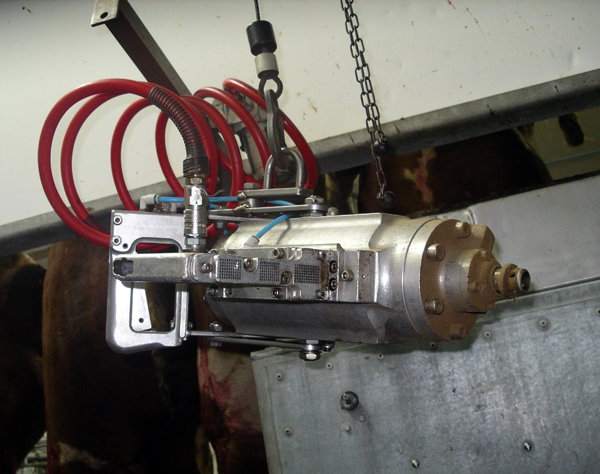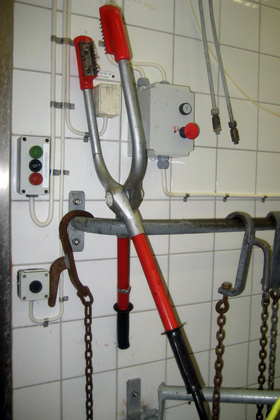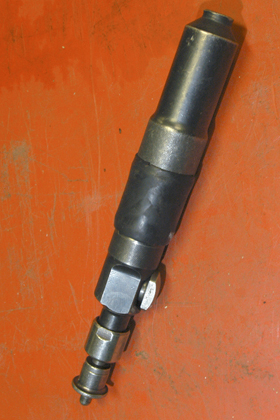All about weapons – information on the equipment
Mechanical stunning
Mechanical stunning uses equipment which can be divided up into:
- Bolts driven with a powder charge
- Compressed air
- Free projectiles driven by powder
It is necessary to follow the manufacturer’s recommendations for all equipment. These recommendations must also be included in the company’s standard procedures for killing. It is also necessary to put in place safeguards in case new equipment or ammunition fails to meet the promises of the manufacturer. This is also applicable to the slaughter of larger animals. In these cases, more powerful reserve weapons must be available.
This method is flexible, quick and relatively cheap. It is suitable for both large-scale slaughter and for individual animals, and can be adapted easily to different animal sizes. It is preferable for large animals. Free-projectile weapons present major risks from a work environment standpoint which must be taken into account.
Stunning with bolt gun
Bolt equipment is available in many price ranges and qualities. The more expensive equipment makes better use of the energy and hence can be used for larger animals. It is also generally quieter. All such items of equipment require good maintenance.
The biggest advantage of bolts compared with free projectiles is that the workplace is not turned into a ”rifle range”. Nor do they require a gun licence.
The speed of the bolt varies between 55 m/s and 100 m/s depending on make. It is important to ensure that the manufacturer’s recommended speeds are maintained.
The energy in powder-driven bolt guns is approx. 400 J (joules).
Bolts driven by a powder charge
These are easy to use but require a fair amount of maintenance. The equipment is relatively light and can be handled with one hand, precisely and quickly. All models have charges of different sizes for different animals. It is important to follow the manufacturer’s recommendations. Unfortunately, it is always necessary to be prepared for the effects to be insufficient when trying new equipment or ammunition or a new type of animal.
Remember!
None of the powder-driven bolt guns available on the market at present are capable of dispatching the large bulls of today!
The designs of the bolt guns may differ widely and have to be adapted depending on the purpose for which they are to be used:
Gun-shaped:
These require you to extend your lower arm to reach. They are best suited to shooting pens with a raised platform for the shooter, or for small animals.
Tubular:
These shoot at 90° from the lower arm.
These allow you to reach larger animals,
even from ground level.
That said, they are not suitable for instances in which you have to stretch forward or down to reach the animal.

Gun-shaped bolt gun of Cash brand (left). Illustration: NIMA

A detailed sketch (right).
Illustration: NIMA



Tubular bolt gun of Schermer brand (left) and a detailed sketch (right). Illustration: NIMA.
Bolt gun of Cash brand without a trigger (right). Illustration: EFSA opinion on welfare aspects of the main systems of stunning and killing the main commercial species of animals” (EFSA Journal (2004), 45, 1-29, Welfare aspects of the main systems of stunning and killing the main commercial species of animals, available at http://www.efsa.europa.eu/en/scdocs/doc/45.pdf, sid 46).
The structures of bolt guns with triggers and bolt guns which are fired when being struck against the target are relatively similar.
A powder charge is fired by means of a mechanism and drives a bolt of a diameter of approx. 7-13 mm, which is ejected by 7-13 cm. The bolt is returned by a spring or rubber bushings.
There are one or more rubber gaskets between the bolt and the cylinder in which it moves, and these are designed to prevent the propellant gas leaking out.
Most bolt guns have a gap between the bolt and the opening so that the bolt has time to accelerate before striking. This is necessary on these weapons so as to have the intended effect. Some bolt gun models have to be held slightly away from the head when fired. It is important to follow the instructions for the weapon used.
Ammunition for bolts with a powder charge
The ammunition comprises a powder charge in a sleeve. The powder charge is ignited by another small charge, which in turn is ignited by the firing pin. There are no bullets in these bolt guns.
Ammunition is available in different weights, designed for different types of animal. These are marked with different colours, but unfortunately manufacturers use different colour codes. The choice of ammunition for various animal types must be indicated in the company’s standard procedures. It is a good idea to post up a list of ammunition used in the workplace and what it is appropriate for. This then reduces the risk of using the wrong colour. The above is an example of a grant at a Swedish slaughterhouse.
Illustration: Arne Mustonen, Vivet.

Colour-coded cartridges for a Schermer bolt gun. Illustration: NIMA.
Never use ammunition which is too weak as this will result in poor stunning. If poor stunning occurs repeatedly, the choice of ammunition must always be queried and checked. If the effect is still poor, the reason for this must be examined.
You may think it is better to choose more powerful ammunition than the ammunition recommended, but this is not the case with killing equipment using bolts. If you use too powerful a charge, the gaskets will wear out quickly, thereby losing their effect. The springs or bushings designed to return the bolt will also be destroyed, impairing the effect.
Ammunition must always be kept locked up and protected from moisture. Ammunition damaged by moisture may misfire, which causes irritation and work environment problems. In the event of a misfire, you must always wait at least 10 seconds before opening the weapon in order to remove the cartridge.
There is a risk of ignition merely being delayed. During this time, the weapon must be held so that the bolt does not strike anything hard or injure anyone. Ideally, there should be a board against which you can rest the bolt as the resistance in the board will protect gaskets, springs and bushings.
Slower-burning powder is another very common result of ammunition being damaged by moisture. This causes the bolts to move much more slowly and results in poor stunning.
Bolt driven by air pressure
Bolt guns driven by compressed air have become more and more popular as they ensure good stunning and do not need to be recharged. These are driven by air supplied via pipelines. The equipment is becoming bigger and heavier, and so it has to be handled with both hands. Such bolt guns are suspended on balancers so as to make them easier to handle.
The disadvantage of the weight is that it makes them slower to handle. As a result, these bolt guns require tighter restraint of the animal. The advantages are that the weight permits bolts with a
larger diameter to be used, and that they are immediately ready
for a second shot. The large-diameter bolt can transfer more energy to the head and so provide better stunning quality.
They are also able to cope with large bulls.

Bolt gun driven by compressed air.Photographer:
Sophie Atkinsson, Swedish University of Agricultural Sciences
Equipment is available for measuring and checking the effect of the bolt guns. It is important to have sufficient amounts of air to operate these guns. Air consumption and operating pressure must be checked carefully and the system must guarantee that there is always sufficient pressure.
Stunning with a free projectile
At slaughterhouses, weapons firing free projectiles should be avoided for work environment reasons, but they are a handy complement for large bulls, timid animals or as spare weapons.
A brief guide to calibres and ammunition
The calibre indicates the size of the cartridge, the diameter of the bullet, the shell and the length of the shell. The calibre is linked to the weapon.
The weapon also affects the speed of the bullet; a long barrel gives a faster speed. Of course, there is room for more powder in a larger cartridge, and a larger bullet diameter will result in a bigger hole and greater weight. But this is not entirely crucial. There are different kinds of powder and various quantities of powder in ammunition for one and the same calibre. This gives rise to differences in bullet speed.
The weight of the bullet is determined not only by its diameter, but also by its length and the material used to make it.
Bullets also come in a range of different shapes and sizes for different purposes. Some bullets retain their shape almost regardless of what happens. These pass through a lot without losing energy. At the same time, they do a relatively small amount of damage on the way and risk emerging on the other side or ending up in the meat.
Not even this is always true, though, as there are bullets which are so unbalanced that they start to roll when they hit something and tear open a large hole in this way.
Other bullets are designed to crack up and spread out when they hit anything. These then cause a large hole and destroy a lot but do not penetrate all that deeply.
There are all kinds of different bullets between these two extremes.
The best thing is to find a bullet which can pass through the skull by a wide margin and then spread out before entering the brain and then stopping in the bone behind the brain!
Thus a lot of knowledge and practical tests are needed in order to find the ideal combination of weapon, charge and bullet for a specific type of animal. New ammunition should be tested to find out how it behaves before being used on live animals.




Various bullets for one and the same calibre with deformation. Photographer: Norma.
All ammunition operates at a much higher speed (360-1200m/s) and much lower weight than bolts. The blow to the skull has less effect with this method, but this is compensated to a degree by the fact that the bullet not only has to pass the front of the skull, but also have the energy to thump down in the skull after passing the brain.
The high speed of the bullet gives a much brisker shockwave when passing through the brain, causing a lot more damage than the bolt. Bullets which spread out also tear a very large wound cavity.
Shotguns operate at low speed but with a large diameter and heavy weight. At short range, the pellets do not act individually, but as a single clump. The most common calibres are 12, 16 and 20 (12 is more powerful than 16). Shotgun cartridges also come in different lengths and with different charges. Using a shotguns at short range (5-25cm) results in excellent, persistent stunning can be achieved even with large bulls. However, they are very loud.
Choosing the right weapon, ammunition and bullet results in very safe stunning which is persistent and will lead to the animal dying if the shot is positioned correctly. The stun-to-stick time is therefore not as important when using free projectiles, e.g. when using a bolt gun, except when it comes to food quality.
Even so the animal may not be struck correctly, which will result in a poorer, shorter-lived stunning effect, and so attempts should be made to stick the animal within 60 seconds in this instance as well. If substandard stunning is suspected, the animal must be stunned again.
Do not forget to check that the weapon can take the ammunition used.
In the case of slaughter, the standard procedures must describe what calibre, charge and bullet are to be used for the animals to be slaughtered. It must be possible to justify these choices so that effective stunning is assured. The positioning on the animal must also be stated.



Use of free projectiles
A selection of useful ammunition for bolt guns and rifles/pistols, from left.
Photographer: Arne Mustonen, ViVet.
- 9*17mm for Dick or Blitz. Cheap and works well on horses, simple design
(take care not to get your finger trapped in the trigger). - 5.6*15mm for Cash Special. Good for sheep, goats, calves, cows and smaller bulls.
- 5.6×15mm .22 Long Rifle rimfire. Rifle for sheep, goats and horses.
- 6.8*15 mm. For Schermer KS. Works very well for steers. Silent.
- 5.6*26 mm, .22WMR, 22 magnum. Good for bulls up to 30 months.
Commonly used for contact-fired guns. - 9.6 mm to slaughter mach. Good for bulls, but not really big ones.
- 9.1*29 mm, .38 special. Suitable for all bulls.
- 5.7*43 mm, .222 Remington. Copes well with large bulls.
- 16.8 mm, cal 16 shot cartridge. Copes well with large bulls.
- 18.5 mm, cal 12 shot cartridge. Copes well with large bulls.
- Cal 12 Magnum with a stronger charge and coarse shot. Strong at the top edge.
- 6.5*55 mm. Good for shooting at longer range at animals which have escaped.
L22 permits this for sheep, goats and pigs only for chest shots. - 7.62*63 mm, .30-06. Powerful cartridge for long-distance killing.
L22 does not permit normally charges .30-06 for long-distance killing of injured adult cattle. - 9.3*62mm. Very powerful cartridge for all long-distance killing.
The advantage with using free projectiles is that projectiles are available in many sizes (calibres), which in terms of power are more than adequate for all potential situations.
It is relatively inexpensive to use free-projectile weapons as long as you work with second-hand hunting weapons, which are often perfectly adequate as precision considerations are not crucial during slaughter on account of the short distance.
When stunning a timid animal with horns in a shooting pen, it is easier to reach the animal with these weapons. When slaughtering, rifles have a maximum shooting distance of 5m, compared with 25 cm for shot.
There are many serious disadvantages
- Careful, systematic work environment management is required to protect staff and the surrounding area from risk. This will require in-depth internal safety training for the people who handle these weapons and strict rules on the presence of other staff in the risk zone. Rules are also required on how the weapons are to be stored when they are not in use. The risk of accidental weapon discharge is obvious.
- Many of the weapons are subject to the requirements of the Weapons Act, which limits purchasing options and handling.
- The bullet (or parts of it) which end up in the animal must not end up in the food. Bullets often include a certain amount of lead, which has an environmental impact even in the slaughterhouse waste.
- The power of the shot may often be regulated by using different weapons with different calibres.
- The noise level is very high. However it is possible to fit silencers which considerably reduce both noise and recoil. Silencers require separate licences.
- Free-projectile weapons may be attractive to thieves, so increasing the risk of burglary.
Free-projectile weapons can be divided as follows:
Contact-fired guns, which are specially manufactured weapons for slaughter and do not require a firearms licence. These require two-handed shooting and/or a device requiring them to be held directly against the head before they can be fired. They must be treated as tools or machines in work environment management.
Above all, contact-fired guns are useful and relatively good from a safety standpoint as they are long and come with silencers, two triggers and pushrods at the end which must be held down when firing. They are often of .22 Winchester Magnum Rimfire (.22WMR, 22 magnum or 5.6*26R) calibre, which is an excellent calibre for animals up to bulls under 30 months of age.

Contact-fired guns
Photographer: Lotta Berg, Swedish University of Agricultural Sciences.
The bell gun (Formator or Cattle) is of a very simple design, with a short barrel and a ”trumpet” on the barrel, at the end. This ”trumpet” allows the gun to be held against the skull when firing. These guns are of 9.6 mm calibre and can be used for large bulls. They are easy to use at ground level for large animals. However, the work environment aspect is dubious as they are short and often have a weak safety catch. They require a hammer for firing.


Bell gun with ammunition (left). Illustration: NIMA.
Bell gun of Formator brand, with cartridge (right).
Photographer: Arne Mustonen, ViVet.
Hunting firearms require licences for which you have to apply to the police. Anyone who has previous hunting licences for weapons can also use these for slaughter. If the weapon is only to be used for slaughter, this must be specified in the application.
Hunting firearms are available as both rifles and shotguns. There is a large selection of various models. However, for slaughter purposes you should restrict yourself to a weapon with a short barrel, the option of attaching a silencer and no option for shooting several shots in rapid succession.

Combination weapon, shot, calibre 12 and .222 Remington with barrel selector and male jack. Photographer: Arne Mustonen, ViVet.